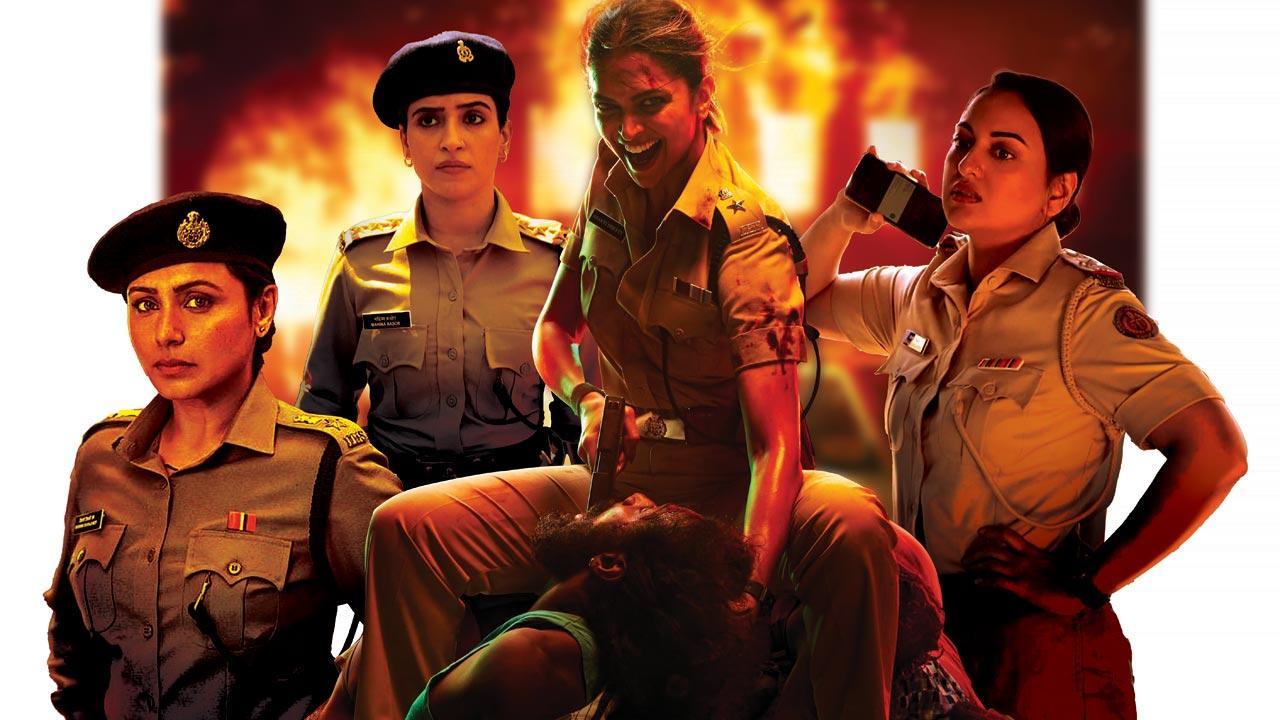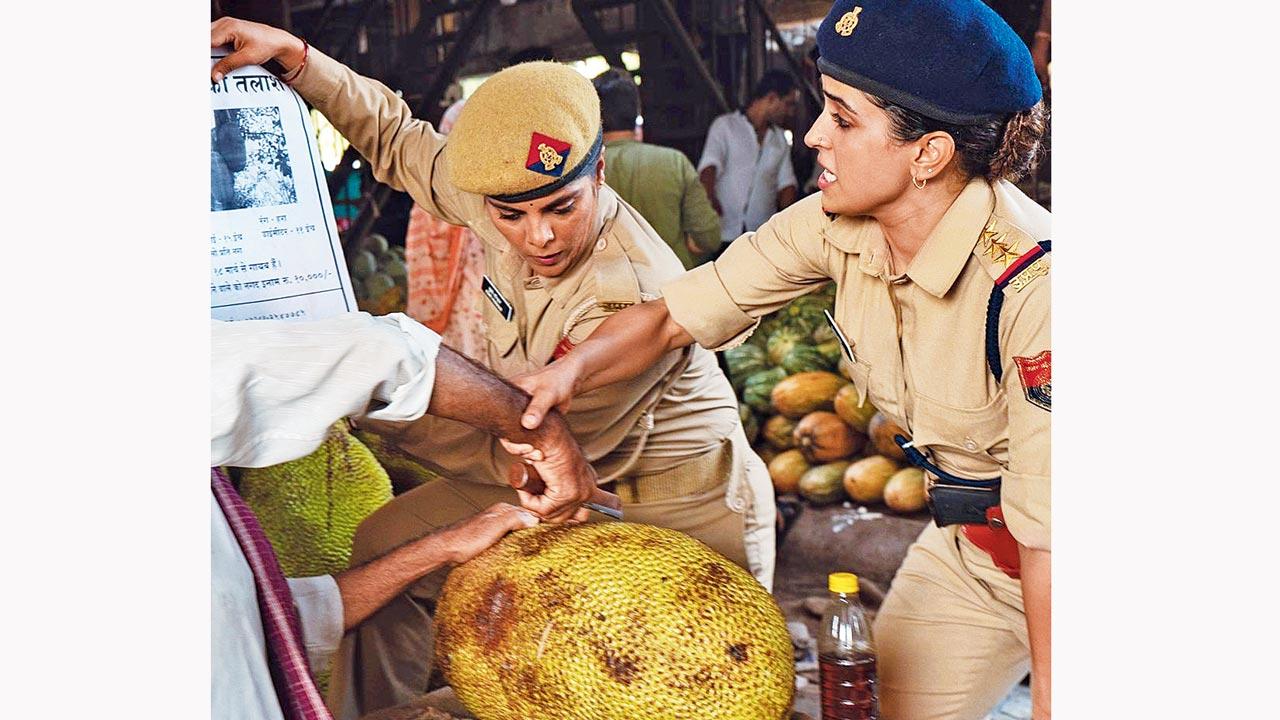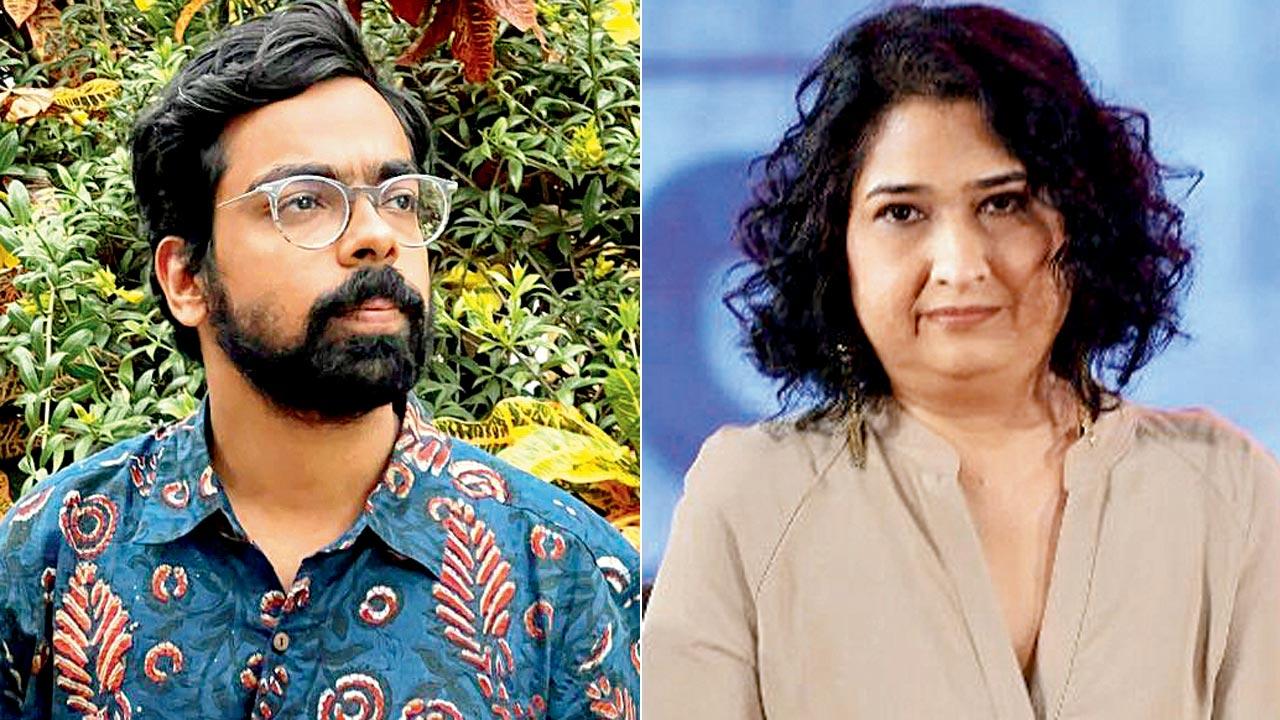The female police officer, an icon of Hindi cinema, has come of age with nuanced depictions and sensitive writing. Filmmakers and scholars tell us why her femininity and agency matter

Photo Illustration/Uday Mohite
In a pivotal scene from the police procedural series Dahaad, Sonakshi Sinha’s Anjali Bhaati finds resistance at the doorstep of a criminal’s house. The fierce police officer is being refused entry by the father of a serial killer who is the series’ main antagonist, played by Vijay Varma. Not because Bhaati may find incriminating evidence in the house—Swarnakar Senior stops her in her tracks because of her caste.
ADVERTISEMENT
The treatment meted out to Bhaati is no different from the way in which Sanya Malhotra’s Mahima Basor is received in the house of an MLA in the Netflix film Kathal. Basor is the investigating officer assigned to a case of missing jackfruits dear to the MLA, played by Vijay Raaz, who grimaces when she dares to step on a carpet in his house.
 Sanya Malhotra’s Mahima Basor examines cases with a kind of clarity that her colleagues simply don’t possess. Pic/Facebook
Sanya Malhotra’s Mahima Basor examines cases with a kind of clarity that her colleagues simply don’t possess. Pic/Facebook
Bhaati and Basor are the latest in a long line of Hindi pop culture heroines who proudly wear the uniform—before them, came Meera Deshmukh (Drishyam), Shivani Shivaji Roy (Mardaani) and Vartika Chaturvedi (Delhi Crime). These protagonists are tied together by their sense of duty and bravery, often in the face of gender-based violence and brutality. With Deepika Padukone and Kareena Kapoor Khan set to make entries into the Singham franchise, what emerges are diverse depictions of the female police officer, shaped not just by filmmakers’ visions but also femininity and female agency in a difficult world.
Pallavi Rao, Assistant Professor of Media Studies at the University of Virginia, says that the centering of a feminine presence in the law and order genre, which is underrepresented, is what stands out. Particularly for the ways in which these characters make or struggle to make a mark. “That struggle is interesting in a male-dominated space which is still hostile to women stakeholders, such as female litigants,” Rao explains. “In the West, too, the female officer has gained popularity through shows such as Castle or The Fall, but in India, she is imagined as the nurturing, intuitive cop—someone attuned to human nature, with an element of maternal or sisterly protectiveness. These are the ways in which the female face of justice is imagined.”
 Sinha’s Anjali Bhaati is aware of what her rights are, and what is due to her
Sinha’s Anjali Bhaati is aware of what her rights are, and what is due to her
In Kathal, a satirical drama directed by Yashowardhan Mishra, Basor cuts through her colleagues’ and superiors’ laziness and lack of accountability by thinking on her feet. She examines cases with a kind of clarity that they simply don’t possess; this is what prompts her to chase the story of a missing girl—the daughter of an ordinary farmer—which is dismissed by another officer.
“I wanted her to be empathetic about the case she is trying to solve,” says Mishra of his multi-dimensional protagonist. “We found in our research that female police officers tend to deal with cases of crimes against women with a lot more sensitivity and urgency, compared to their male counterparts. The research shattered many of our preconceived notions.”
 Yashowardhan Mishra and Ruchika Oberoi
Yashowardhan Mishra and Ruchika Oberoi
The writer-director leaned greatly into the research he and his team conducted on women in the force. Basor’s approachable nature is guided by his finding that the police, too, want to be approachable to the public. “We wanted her to be real and sensitive,” he adds. “The film depicts real problems, which need real solutions—and the solution isn’t always filmy or typical.”
Mishra was certain that Basor should be more than just a police officer, and more than the case she tries to solve. In Malhotra’s portrayal, we don’t see the masculine exterior that is characteristic of other depictions. “I love how she wears her femininity. In the prep we did with Malhotra, we met police officers [and some of them, we noticed] wore lipstick [on the job]. There’s no need for her to act masculine or aggressive just because she’s in the police; her job isn’t about brute force,” Mishra explains.
While Basor’s character was crafted based on true stories, Dahaad’s protagonist was moulded by both research as well as the makers’ aspirations for her.
Sinha’s character, who is trying to find 27 missing women in Rajasthan, is called Bhaati sahab by her juniors. She also rides a motorbike and enjoys a secret sex life. Director Ruchika Oberoi says that Anjali Bhaati is empowered in some ways, and not in others. “We imagined Anjali as someone who has the courage to speak to her superiors,” Oberoi says. “Her father had great belief in her, and she has a lot of faith in herself, which shows in her mannerisms. She does what she sees as being right, she doesn’t pay heed to the moral compass of those around her—she’s above it.”
In making Bhaati the eyes through which we see Mandawa, the Rajasthani town where Dahaad is set, we learn about how its marginalised are treated. Oberoi says that she and the writers didn’t want it to be a series where a male protagonist solves problems faced by female victims. “We wanted a character from the same milieu... The facts of the case are in front of the other officers too, but they don’t see them the way Anjali does,” the director says.
Recalling Hema Malini’s Andhaa Kaanoon and Rekha’s Phool Bane Angaray, Minakshi Bujarbaruah, research head at Civic Studios, says that the female police officer has long been a part of Hindi cinema. The emergence of such “strong” characters is a consequence of a paradigm shift—of filmmakers and writers envisioning women beyond conventional roles. That being said, these characters must be examined based on the place they find in the larger narrative. “It is important to look at them by the depth and complexity of the character development, the choices they make—whether at all they are able to—and the character’s overall arc to the larger plot,” Bujarbaruah explains.
She adds that the profession of the character alone does not define the power and agency they possess. “While a Sonakshi Sinha as Sub-Inspector Anjali Bhaati or a Shefali Shah as DCP Vartika Chaturvedi portray a certain degree of power and agency in their roles, they also experience their share of societal scrutiny, stemming from gender stereotypes.
The hurdles that Basor and Bhaati encounter aren’t just related to the crimes they’re investigating. In one scene, Malhotra is at the receiving end of suggestive remarks from another officer, who goes as far as to comment on her figure. Bhaati, who adeptly narrows down leads and is the only one who correctly estimates the cause of the crime, is not always taken seriously by superiors. For both these women, the respect and authority the uniform brings, has its limitations.
“She has managed to earn respect through her rank as an officer—or at least she thinks she has—but society does not afford her this respect all the time. The vardi is not the solution for everything; some problems are deep-rooted. She has to fight her way through those instances,” Mishra says.
Yet the profession—and the way these characters have been written—is also taking them to places where other women of their stature cannot be. Oberoi notes that given Bhaati’s social background, her government job is an empowering life change. “At the same time, she is many steps ahead of, and different from, many of her colleagues. She is aware of her rights, of what is due to her—and she demands that,” the director says. “She’s not ready to give up that space to those who feel she doesn’t belong. She’s a person who loves challenges; she also feels that if she doesn’t set an example, who will?”
These meticulously etched characters give the audience an unvarnished glimpse into what policing involves—especially the everyday challenges of female officers. “Their portrayal helps humanise the people they are based on,” Bujarbaruah says, “urging the audience to look at their struggles, emotions and complexities. They also emphasise realities like the overworked and understaffed police system with a high caseload; and the need for reforms and better policies in a country like India.”
Rao observes that many characters who wear the uniform are seen as agents capable of shaking up entire systems. “Take for example interrogation scenes where the female protagonist is more appealing and effective than her male counterparts. It’s the feminisation of a profession to see what a woman can bring to it,” she explains.
In eliciting audience empathy for these characters, is pop culture promoting an uncritical view of the police force? Mishra says that when working on this subject, there is the risk of the glorification of gratuitous violence, which he wanted to steer clear of. “Basor manages to find her way without using brute force, which we see in a lot of Hindi cinema. We wanted her to find justice through Constitutional means and dignity.”
 Subscribe today by clicking the link and stay updated with the latest news!" Click here!
Subscribe today by clicking the link and stay updated with the latest news!" Click here!







